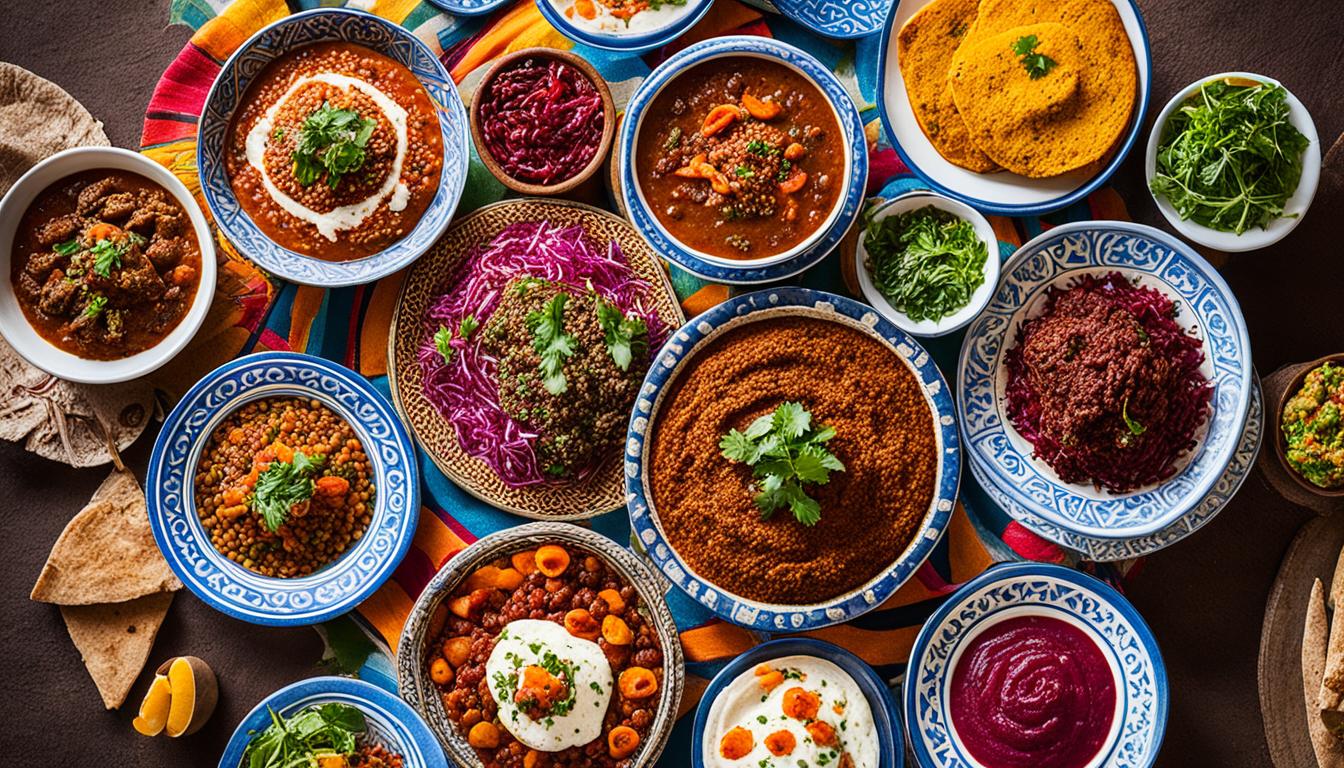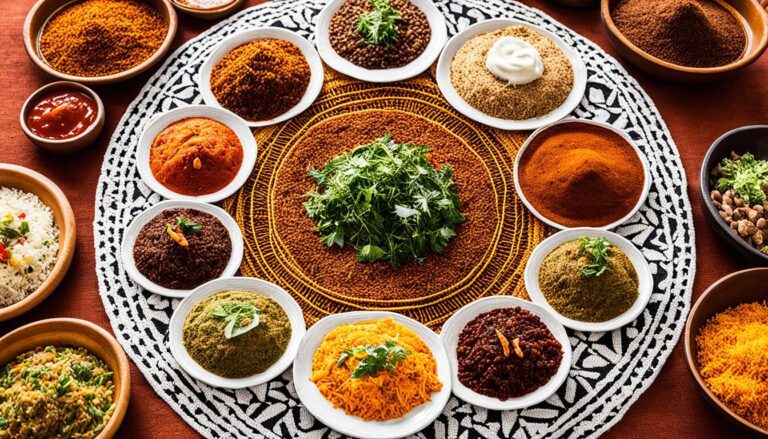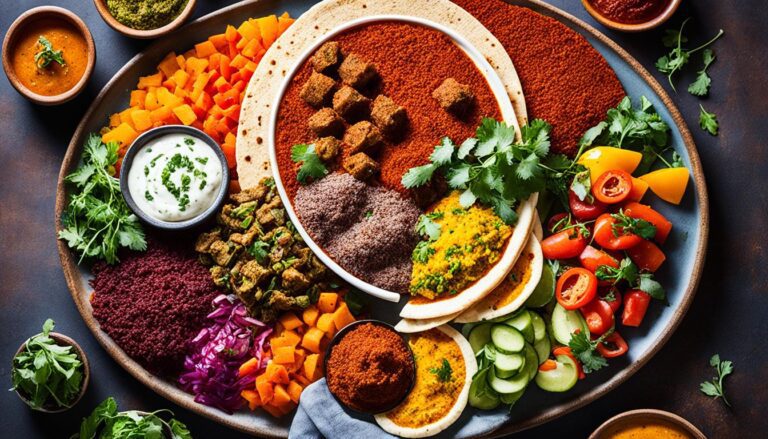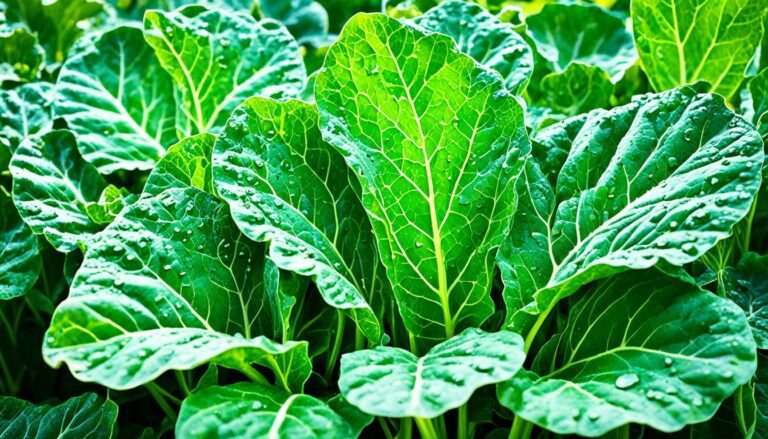How Make Ethiopian Food?
Welcome to our culinary journey through the vibrant and diverse world of Ethiopian cuisine. Have you ever wondered how to recreate the rich flavors, bold spices, and exotic aromas of Ethiopian food in your own kitchen? Look no further, as we are here to guide you on a delicious adventure of making Ethiopian dishes from scratch. Get ready to embrace the flavors of East Africa and experience the magic of Ethiopian cooking.
From injera, the spongy and tangy flatbread, to fragrant stews bursting with flavors and aromas, Ethiopian food offers a unique culinary experience that is sure to tantalize your taste buds. Whether you are an experienced home cook or a beginner in the kitchen, our step-by-step guide will help you master the art of Ethiopian cooking and create authentic dishes that will transport you to the bustling markets and vibrant kitchens of Ethiopia.
Key Takeaways:
- Discover the rich flavors and vibrant traditions of Ethiopian cuisine
- Learn how to make traditional Ethiopian dishes from scratch
- Explore the essential spices and ingredients that give Ethiopian food its distinctive taste
- Try your hand at classic Ethiopian recipes, perfect for beginners
- Delve into the world of Ethiopian vegetarian delights for plant-based options
Ethiopian Cuisine: A Taste of Tradition
Before we dive into the recipes, let’s explore the unique and diverse culinary landscape that is Ethiopian cuisine. The rich heritage and traditions of Ethiopian dishes have delighted food enthusiasts worldwide for centuries.
At the heart of Ethiopian cuisine is the communal dining experience, where friends and family gather around a large platter and share a variety of flavorful dishes. This cultural practice reflects the warm and hospitable nature of the Ethiopian people.
One of the defining characteristics of Ethiopian cuisine is the injera, a spongy fermented bread made from teff flour. It serves as a versatile base for many traditional Ethiopian dishes, both vegetarian and meat-based.
From fragrant and spicy stews like doro wat (chicken stew) and key wat (beef stew) to hearty lentil soups and aromatic vegetable dishes, Ethiopian cuisine offers a wide range of options to satisfy every palate. Utilizing a variety of aromatic spices, such as berbere and mitmita, traditional Ethiopian dishes pack a punch of flavors that create a harmonious balance on your taste buds.
Traditional Ethiopian Dishes
Let’s take a closer look at some of the most popular traditional Ethiopian dishes:
- Kitfo: A delicacy made from minced raw beef, typically marinated in spices and served with injera.
- Tibs: Tender pieces of meat or vegetables sautéed with aromatic spices and herbs.
- Shiro: A thick stew made from legumes, such as chickpeas or lentils, seasoned with spices and often served with injera.
- Doro wat: A rich and flavorful chicken stew cooked with berbere spice blend, onions, and various aromatic herbs.
- Injera: A staple Ethiopian bread made from fermented teff flour, often used as a utensil to scoop up other dishes.
These dishes are just a glimpse into the delightful world of Ethiopian cuisine. Each bite tells a story and provides a glimpse into the country’s rich cultural heritage.
Join us on this culinary journey as we explore the vibrant flavors and traditional dishes of Ethiopian cuisine. In the next section, we’ll introduce you to the essential spices and ingredients that bring these dishes to life.
Essential Ethiopian Spices and Ingredients
To master the art of Ethiopian cooking, it’s crucial to understand the key spices and ingredients that give these dishes their distinctive taste. Ethiopian cuisine is renowned for its bold flavors and aromatic blends, which are achieved through the skillful use of a variety of spices and ingredients.
One of the most essential Ethiopian spices is berbere, a fiery and complex blend of chili peppers, garlic, ginger, and various other spices. This vibrant spice mixture is the backbone of many Ethiopian dishes, adding a rich and smoky flavor.
Another staple in Ethiopian cooking is mitmita, a potent seasoning made from ground bird’s eye chili peppers, cloves, cardamom, and other spices. Mitmita adds a spicy kick to dishes and is particularly popular in Ethiopian meat dishes.
When it comes to Ethiopian ingredients, teff is a vital grain that forms the basis of injera, the spongy flatbread that is a staple in Ethiopian cuisine. Teff is a highly nutritious ancient grain packed with protein, fiber, and essential vitamins and minerals.
Niter kibbeh is another crucial ingredient in Ethiopian cooking. It is a spiced clarified butter that adds depth and richness to dishes. Made from simmering clarified butter with a blend of spices like cardamom, cloves, and fenugreek, niter kibbeh imparts a unique flavor and aroma.
Other common Ethiopian ingredients include berbere, a spice paste made from ground chili peppers, garlic, ginger, and other spices; shiro, a flavorful spice blend made from ground legumes; and awaze, a spicy dipping sauce typically made from berbere.
By incorporating these essential Ethiopian spices and ingredients into your cooking, you can unlock the vibrant flavors and rich traditions of Ethiopian cuisine.
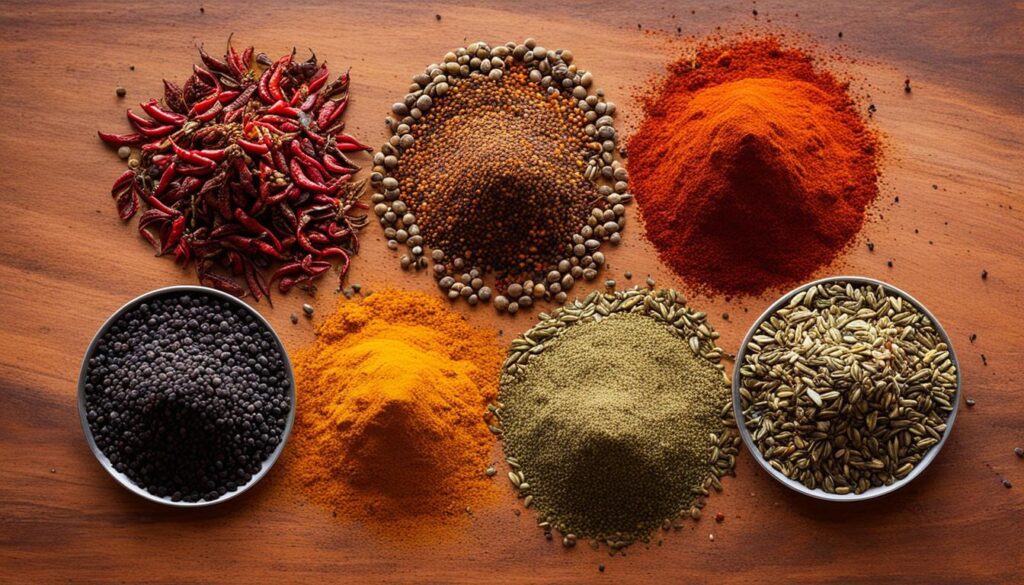
Classic Ethiopian Recipes for Beginners
Now it’s time to roll up our sleeves and start cooking! We’ll walk you through some classic Ethiopian recipes that are perfect for beginners. Get ready to embark on a flavorful culinary journey that will transport you to the vibrant streets of Ethiopia.
Injera: The Staple Ethiopian Bread
Let’s start with the foundation of Ethiopian cuisine: injera. This spongy, sourdough flatbread is a must-have accompaniment to any Ethiopian meal. Made from fermented teff flour, injera is not only delicious but also provides a unique texture that complements the bold flavors of Ethiopian dishes.
Preparing injera requires a bit of patience and a few days of fermentation, but the end result is worth it. Our step-by-step guide will help you master the art of making this traditional Ethiopian bread.
Doro Wat: A Flavorful Chicken Stew
Doro wat is one of Ethiopia’s most famous dishes and a must-try for any Ethiopian food enthusiast. This hearty chicken stew is bursting with flavors, thanks to a rich blend of spices and aromatic ingredients.
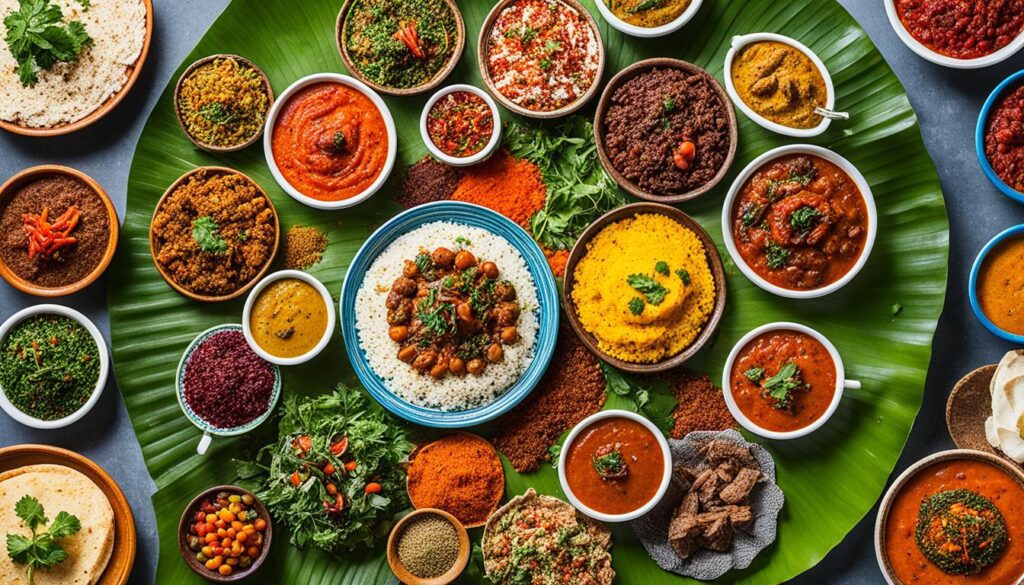
To create an authentic doro wat, you’ll need berbere spice, a blend of chili peppers, paprika, and other aromatic spices. The stew is traditionally served with injera, creating a delicious combination of flavors and textures.
Our easy-to-follow recipe will guide you through the process of making doro wat, allowing you to savor the taste of Ethiopia in your own home.
Tibbs: A Tasty Ethiopian Beef Stir-Fry
If you’re a fan of beef, then you’ll love tibbs. This Ethiopian-style stir-fry combines tender strips of beef with onions, peppers, and a flavorful spice mix.
The secret to a delicious tibbs lies in the berbere spice blend, which adds a unique and distinctive taste to the dish. With a balance of heat, sweetness, and hints of earthiness, tibbs is sure to please your taste buds.
Our recipe will show you how to perfectly cook the beef, ensuring it remains succulent and packed with flavor. Serve it with injera or rice for a complete Ethiopian dining experience.
With these classic Ethiopian recipes, you’ll be able to bring a taste of Ethiopia to your own kitchen. Whether you’re new to Ethiopian cuisine or a seasoned enthusiast, these beginner-friendly dishes are sure to impress. So grab your apron and let’s start cooking!
Exploring Ethiopian Vegetarian Delights
When it comes to Ethiopian cuisine, it’s not just about the rich flavors and vibrant spices. Ethiopian food also has a lot to offer for vegetarians. In this section, we invite you to discover the world of Ethiopian vegetarian delights. From hearty lentil stews to flavorful collard greens, you’ll find a variety of plant-based Ethiopian dishes that will satisfy your taste buds and leave you craving for more.
One of the most popular vegetarian dishes in Ethiopian cuisine is Misir Wot, a delicious lentil stew simmered in aromatic spices. The combination of lentils, onions, and berbere spice creates a hearty and flavorful dish that pairs perfectly with injera, the traditional Ethiopian bread.
Another vegetarian favorite is Gomen, a dish made with collard greens sautéed in garlic, onions, and spices. This flavorful side dish is not only packed with nutrients but also adds a pop of vibrant green color to your plate.
For those who enjoy a bit of heat, Shiro is a must-try Ethiopian dish. Made with ground chickpeas or lentils, this spicy stew is bursting with flavors and will leave you wanting more.
And let’s not forget about the tangy and refreshing Ethiopian salads. From Azifa, a simple yet flavorful green lentil salad, to Timatim Fitfit, a zesty tomato and bread salad, Ethiopian salads are a perfect way to incorporate fresh and healthy ingredients into your meal.
Whether you’re a vegetarian or simply looking to explore more plant-based options, Ethiopian cuisine has something for everyone. The combination of aromatic spices, hearty legumes, and vibrant vegetables create unique and satisfying dishes that will delight your taste buds and nourish your body.
Ethiopian Coffee Rituals and Sweet Treats
Ethiopian coffee is more than just a beverage; it’s a cultural experience steeped in centuries-old rituals. In Ethiopia, coffee is treated with great respect, and the brewing process is considered an art form. Join us as we delve into the captivating world of Ethiopian coffee rituals, where every sip carries the essence of tradition and community.
First, let’s talk about the rich aroma that fills the air when Ethiopian coffee is brewed. The Ethiopian coffee beans are known for their distinctively vibrant flavors, often exhibiting floral, fruity, and wine-like undertones. From the moment you take your first whiff, you’ll be transported to the lush Ethiopian coffee farms, where the beans are handpicked with care.
The traditional Ethiopian coffee brewing ceremony, known as “Buna,” is a sight to behold. It typically takes place in a special room called the “Betsimisar,” adorned with traditional Ethiopian decorations. The beans are first roasted on an open flame, filling the air with an enticing smoky fragrance.
During the ceremony, the coffee is brewed in a traditional clay pot called a “jebena.” As the water boils, the captivating aroma intensifies, signaling the start of a communal gathering. The coffee is poured into small cups known as “ceramic jebenas,” and each cup is served with a side of snacks and sweet treats.
Speaking of sweet treats, let’s explore some of the delightful Ethiopian desserts that perfectly complement a cup of Ethiopian coffee. One popular and addictive treat is dabo kolo – small, spiced bread bites that are often enjoyed as a snack or dessert. They have a unique crunch and are infused with flavors like cardamom and cinnamon.
Another mouthwatering Ethiopian dessert is halva, a sweet sesame-based confection. Halva is made by caramelizing sesame seeds, then blending them with honey or sugar to create a rich, dense treat. It’s often enjoyed alongside a cup of Ethiopian coffee, adding a touch of sweetness to balance the bold flavors.
So, whether you’re sipping Ethiopian coffee or indulging in the delectable desserts, you’re immersing yourself in the vibrant flavors and rich traditions of Ethiopia. Join us as we celebrate the Ethiopian coffee rituals and embrace the sweet delights that accompany this cultural experience.
Tips for Achieving Authentic Ethiopian Flavors
Want to bring the vibrant and complex flavors of Ethiopia to your kitchen? Look no further! We are here to share some valuable tips and tricks that will help you achieve authentic Ethiopian flavors in your dishes.
1. Proper Spice Blending: Ethiopian cuisine is known for its rich and aromatic spices. To create authentic flavors, it’s essential to master the art of spice blending. Experiment with a variety of Ethiopian spices like berbere, mitmita, and turmeric to create depth and complexity in your dishes.
2. Quality Ingredients: Using high-quality ingredients is key to achieving authentic flavors. Seek out authentic Ethiopian ingredients, such as teff flour, niter kibbeh (Ethiopian spiced butter), and injera (traditional Ethiopian bread), to ensure an authentic taste experience.
3. Slow Cooking: Many Ethiopian dishes require long, slow cooking to develop deep flavors. Take your time when cooking stews and curries, allowing the ingredients to simmer and blend together to create rich, savory flavors.
4. Mastering Injera: Injera, a spongy fermented bread, is a staple in Ethiopian cuisine. Learn the art of making injera, as it not only complements Ethiopian dishes but also contributes to the overall flavor profile of the meal.
5. Try Traditional Cooking Methods: Ethiopian cuisine has its unique cooking methods that contribute to its authentic flavors. Explore techniques like the use of mitad (a traditional Ethiopian clay pan) or using a berbere spice-infused oil to bring that extra touch of authenticity to your dishes.
6. Embrace Bold Flavors: Ethiopian cuisine is known for its bold and spicy flavors. Don’t be afraid to experiment with heat and spice. Adjust the amount of berbere or other Ethiopian spices to suit your taste preferences and achieve the perfect balance of flavors.
7. Seek Inspiration: Expand your knowledge of Ethiopian flavors by exploring Ethiopian cookbooks, online resources, and even connecting with the Ethiopian community in your area. Learning from Ethiopian chefs and home cooks will provide you with valuable insights and techniques.
With these tips and tricks, you’ll be well on your way to creating dishes with authentic Ethiopian flavors that will transport you to the vibrant streets of Addis Ababa or the traditional Ethiopian homes. So, let’s dive into the world of Ethiopian cooking and unlock the secrets of this incredible cuisine!
Conclusion
In conclusion, we hope this guide has inspired you to embark on a culinary adventure and try your hand at making Ethiopian food. By exploring the rich traditions and diverse flavors of Ethiopian cuisine, you can bring the vibrant and authentic taste of Ethiopia into your own kitchen.
Throughout this article, we have introduced you to the fascinating world of Ethiopian cuisine. From the essential spices and ingredients to the classic recipes and vegetarian delights, we have provided a comprehensive overview to help you get started.
Whether you’re a beginner or an experienced cook, Ethiopian food offers something for everyone. So gather your spices, prepare your ingredients, and be ready to experience the bold and complex flavors that define Ethiopian cuisine. Don’t forget the injera, the traditional bread that accompanies many Ethiopian dishes, as it plays a vital role in creating an authentic Ethiopian dining experience.
So, why wait? Let’s bring the warmth and aromas of Ethiopian cuisine into your home today. With our guide as your companion, you are well-equipped to explore the wonderful world of Ethiopian flavors and create memorable meals for yourself and your loved ones.

